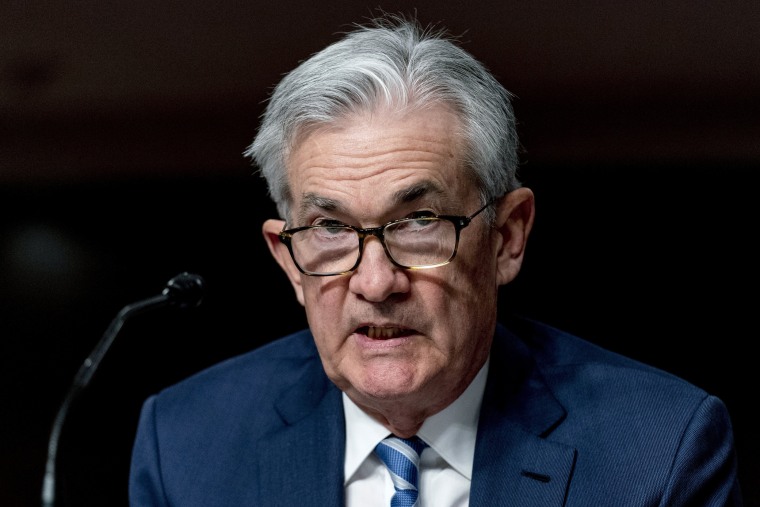The Federal Reserve is further tightening up its pandemic-era easy money policy and will increase the pace of tapering, a move that could usher in rate hikes earlier than expected, according to a statement released at the conclusion of the central bank's latest policymaking meeting on Wednesday.
“In light of inflation developments and the further improvement in the labor market,” members of the Fed’s policymaking committee voted unanimously to wrap up its massive bond-buying program in half the time it initially anticipated, and projected three rate hikes in 2022.
The Fed will double down on its monthly asset purchase reduction, buying just $60 billion in Treasuries and mortgage-backed securities, down from the original $120 billion 18 months ago. The central bank announced in November that it would begin tapering by the amount of $15 billion a month, which it will now double starting in January.
The purchases were part of a strategy to stabilize the financial system when it was feared that global shutdowns resulting from Covid-19 could trigger an economic collapse. The new pace means the program will conclude in March rather than in June.
"Just one month after initiating the taper, they have doubled the pace of withdrawal in an effort to conclude by March so they can raise interest rates sooner,” said Greg McBride, chief financial analyst at Bankrate. “The omicron variant is a wild card for both Fed policy and the overall economy. Until there is greater clarity about transmissibility and possible economic fallout, the Fed has left themselves room to reverse course should it become necessary.”
Omicron and inflation have left Wall Street on edge in recent days, and investors have been anxious about how the Federal Reserve will lay out its plan to navigate these twin economic threats.
Data released last week found that consumer inflation hit a four-decade high, and the Department of Labor reported Tuesday that wholesale prices jumped at a record rate of 9.6 percent from a year ago.
“I think it’s the impact on the broader population that’s really the Fed’s challenge,” said Stephen Lee, principal of Logan Capital Management.
In recent comments, Fed Chairman Jerome Powell, who was renominated last month to lead the Fed for another four years, has retreated from describing price increases as “transitory.” There is widespread expectation that he will use his Wednesday afternoon press conference to announce that the Fed will wrap up its pandemic-era bond-buying program more quickly than it initially planned.
“There’s a real risk now… that inflation may be more persistent,” Powell said Wednesday in a press conference after the meeting.
In response to questions about the time frame between the end of the taper and the initiation of rate increases, he said it was not a topic on which policymakers have focused yet.
“Financial conditions can change very quickly” and can “fairly rapidly” affect the economy, Powell said. “We’re not going back to the same economy.”

Policymakers have offset previous macroeconomic shocks in the past by increasing the money supply and adopting more accommodative positions, but that playbook isn’t a go-to this time around. The Fed can’t do anything about factory shutdowns in Asia or container ships queued up off the coast of California, said Ross Mayfield, investment strategy analyst at Baird.
“A lot of the inflationary pressures are on the supply side of the equation, which the Fed can’t do much about,” he said.
Dysfunction in D.C. also doesn’t help. “You’ve got policy uncertainty as well as Covid uncertainty. It really makes the Fed’s job a little more challenging,” Lee said, pointing to the ongoing wrangling in Washington.
Some lawmakers, primarily but not exclusively Republicans, have criticized President Biden’s Build Back Better economic agenda, saying that the roughly $1.7 trillion package would contribute to inflation by pouring more money into an economy that already shows signs of overheating and as well as putting more pressure on already-strained supply chains, which could exacerbate the climbing costs for a growing list of goods and services.
Different studies have produced a variety of conclusions, and analysts likewise are split on the likely impact — particularly given the uncertainty around the extent and duration of supply-chain issues moving into the new year.
Ethan Harris, head of global economics research for Bank of America, warned in a new report that adding demand in an economy already facing tight supplies of both materials and labor could drive prices up further. “In our opinion, the proposed increases in investment would stimulate demand more than supply in the short run, creating inflationary risks,” he wrote, although he noted that the ultimate impact could differ depending on what the final legislation includes.
Harris also called the Build Back Better Act “quite progressive in the short run,” though. He noted that lower-income families would benefit from multiple new tax credits — which would achieve a key goal of the platform advanced by Biden’s economic team.